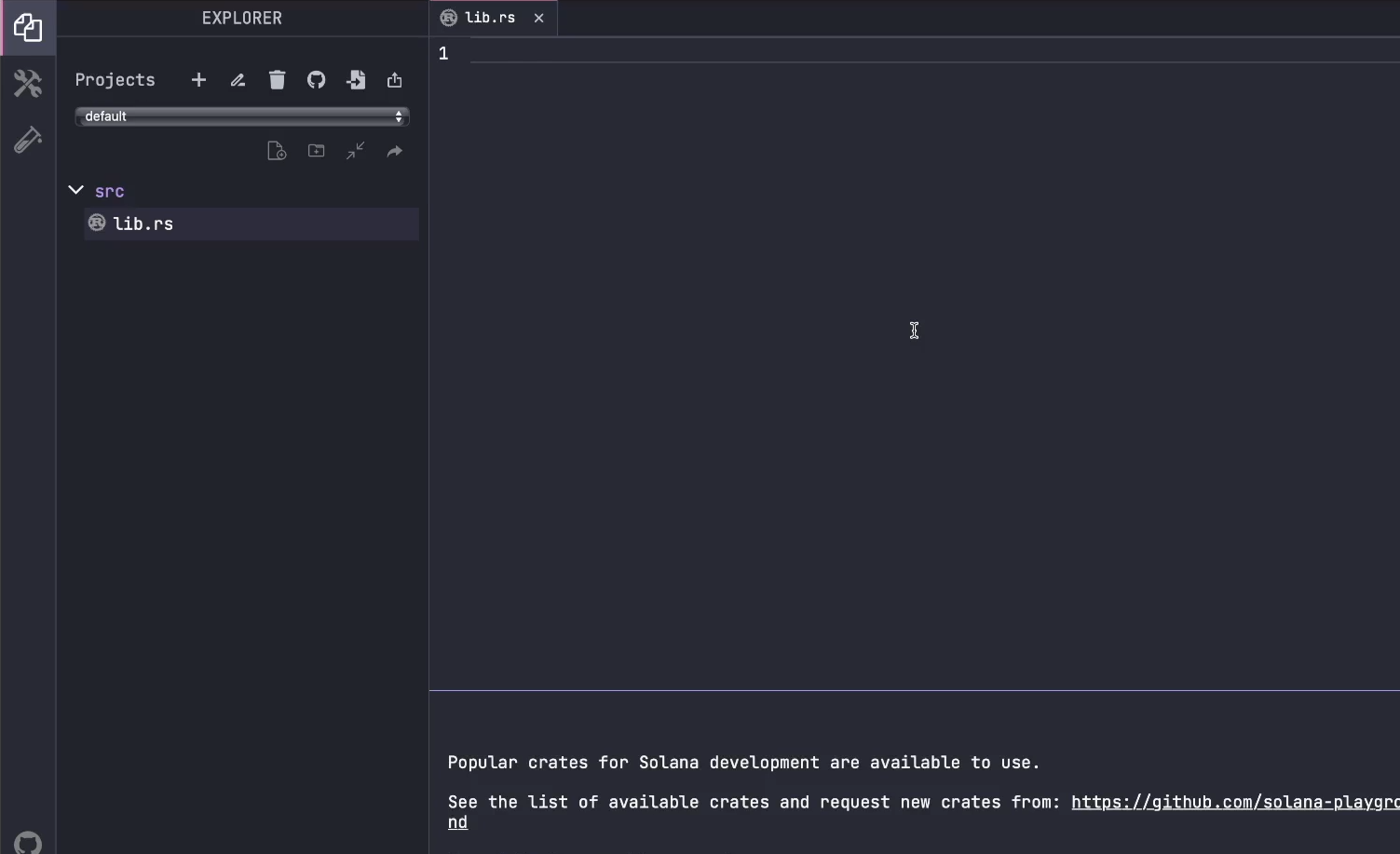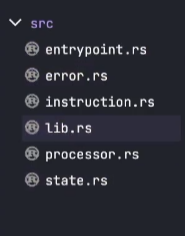🛠️ 构建NFT质押程序
今天,我们将编写质押程序,并实现所有必要的质押功能,暂时不涉及任何代币转账。我将陪伴你,一步一步讲解整个过程,解释每个环节,以便你了解正在进行的操作。首先,让我们进入Solana Playground,点击create a new project,并创建一个名为src的新文件夹,其中包括一个名为lib.rs的文件。
这就是你的集成开发环境应该呈现的样子。
目前,主要目标是编写一个程序,跟踪每个用户的质押状态。下面是一些基本步骤:

准备就绪后,我们将继续创建剩余的文件,就像我们在之前的课程中所做的那样。让我们继续在你的src文件夹中创建以下5个文件:entrypoint.rs,error.rs,instruction.rs,processor.rs和state.rs。
现在,文件结构应该如下所示:

我们已经准备好了!现在让我们用以下代码填充我们的lib.rs文件:
// Lib.rs
pub mod entrypoint;
pub mod error;
pub mod instruction;
pub mod processor;
pub mod state;
接着,进入entrypoint.rs并添加以下代码:
// Entrypoint.rs
use solana_program::{
account_info::AccountInfo,
entrypoint,
entrypoint::ProgramResult,
pubkey::Pubkey
};
use crate::processor;
// This macro will help process all incoming instructions
entrypoint!(process_instruction);
pub fn process_instruction(
program_id: &Pubkey,
accounts: &[AccountInfo],
instruction_data: &[u8]
) -> ProgramResult {
processor::process_instruction(program_id, accounts, instruction_data)?;
Ok(())
}
当你运行代码时,会注意到一个错误,因为我们还没有在processor.rs中定义process_instruction函数。现在让我们创建这个函数。转到processor.rs并添加以下代码:
// Processor.rs
use solana_program::{
account_info::AccountInfo,
entrypoint::ProgramResult,
pubkey::Pubkey
};
pub fn process_instruction(
program_id: &Pubkey,
accounts: &[AccountInfo],
instruction_data: &[u8]
) -> ProgramResult {
Ok(())
}
修复了processor.rs的错误后,你可能会注意到编译代码时仍有一些错误。这是因为在你的lib.rs中,我们导入了一些空模块。不过别担心,我们会在下一节中修复它们 😊 在开始处理process_instruction中的任何内容之前,我们需要在instruction.rs中编写我们的指令,所以让我们开始定义我们的指令。
继续创建一个名为StakeInstruction的枚举,并向其中添加四个指令。基本上,这是定义我们的指令应执行什么操作的地方。将下面的代码复制粘贴到你的instruction.rs中:
// Instruction.rs
use solana_program::{ program_error::ProgramError };
pub enum StakeInstruction {
InitializeStakeAccount,
Stake,
Redeem,
Unstake
}
impl StakeInstruction {
pub fn unpack(input: &[u8]) -> Result<Self, ProgramError> {
let (&variant, _rest) = input.split_first().ok_or(ProgramError::InvalidInstructionData)?;
Ok(match variant {
0 => Self::InitializeStakeAccount,
1 => Self::Stake,
2 => Self::Redeem,
3 => Self::Unstake,
_ => return Err(ProgramError::InvalidInstructionData)
})
}
}
现在让我们深入了解一下我们在这里做的事情。在instruction.rs中,我们创建了一个枚举,用来表示每个离散的指令,并创建了一个解包函数来反序列化数据,这里的数据是一个整数。
让我们返回到 processor.rs 文件并定义我们的 process_instruction 函数:
// processor.rs
use solana_program::{
account_info::{AccountInfo, next_account_info},
entrypoint::ProgramResult,
pubkey::Pubkey,
};
use crate::instruction::StakeInstruction;
pub fn process_instruction(
program_id: &Pubkey,
accounts: &[AccountInfo],
instruction_data: &[u8]
) -> ProgramResult {
let instruction = StakeInstruction::unpack(instruction_data)?;
match instruction {
StakeInstruction::InitializeStakeAccount => process_initialize_stake_account(program_id, accounts),
StakeInstruction::Stake => process_stake(program_id, accounts),
StakeInstruction::Redeem => process_redeem(program_id, accounts),
StakeInstruction::Unstake => process_unstake(program_id, accounts),
}
}
/**
此函数的作用是创建一个属于您和您的NFT的独特PDA账户。
这将存储有关程序状态的信息,从而决定它是否已质押。
**/
fn process_initialize_stake_account(
program_id: &Pubkey,
accounts: &[AccountInfo]
) -> ProgramResult {
let account_info_iter = &mut accounts.iter();
let user = next_account_info(account_info_iter)?;
let nft_token = next_account_info(account_info_iter)?;
let stake_state = next_account_info(account_info_iter)?;
let system_program = next_account_info(account_info_iter)?;
Ok(())
}
fn process_stake(
program_id: &Pubkey,
accounts: &[AccountInfo]
) -> ProgramResult {
Ok(())
}
fn process_redeem(
program_id: &Pubkey,
accounts: &[AccountInfo]
) -> ProgramResult {
Ok(())
}
fn process_unstake(
program_id: &Pubkey,
accounts: &[AccountInfo]
) -> ProgramResult {
Ok(())
}
请注意,我们在 process_initialize_stake_account 函数中定义了一些变量,但它们在任何地方都没有被使用。这是因为我们需要一个结构体来表示程序的当前状态。因此,让我们转到 state.rs 文件并定义我们的结构体。
// state.rs
use borsh::{BorshSerialize, BorshDeserialize};
use solana_program::{
program_pack::{IsInitialized, Sealed},
pubkey::Pubkey,
clock::UnixTimestamp,
};
#[derive(BorshSerialize, BorshDeserialize, Debug)]
pub struct UserStakeInfo {
pub is_initialized: bool,
pub token_account: Pubkey,
pub stake_start_time: UnixTimestamp,
pub last_stake_redeem: UnixTimestamp,
pub user_pubkey: Pubkey,
pub stake_state: StakeState,
}
impl Sealed for UserStakeInfo {}
impl IsInitialized for UserStakeInfo {
fn is_initialized(&self) -> bool {
self.is_initialized
}
}
#[derive(BorshSerialize, BorshDeserialize, Debug, PartialEq)]
pub enum StakeState {
Staked,
Unstaked,
}
🚫 自定义错误
现在我们来到 error.rs 文件,为我们的程序定义一些自定义的错误。
// error.rs
use solana_program::{program_error::ProgramError};
use thiserror::Error;
#[derive(Debug, Error)]
pub enum StakeError {
#[error("账户尚未初始化")]
UninitializedAccount,
#[error("派生的PDA与传入的PDA不符")]
InvalidPda,
#[error("无效的代币账户")]
InvalidTokenAccount,
#[error("无效的质押账户")]
InvalidStakeAccount,
}
impl From<StakeError> for ProgramError {
fn from(e: StakeError) -> Self {
ProgramError::Custom(e as u32)
}
}
太棒了,现在您已经在 error.rs 文件中创建了自定义错误的枚举。当您运行程序时,不应再出现任何错误。
🫙 完善代码
现在,让我们返回到 processor.rs 文件,并完成 process_initialize_stake_account 函数。
// processor.rs
use solana_program::{
account_info::{ AccountInfo, next_account_info },
entrypoint::ProgramResult,
pubkey::Pubkey,
msg,
sysvar::{ rent::Rent, Sysvar },
clock::Clock,
program_pack::IsInitialized,
system_instruction,
program::invoke_signed,
borsh::try_from_slice_unchecked,
program_error::ProgramError
};
use borsh::BorshSerialize;
use crate::instruction::StakeInstruction;
use crate::error::StakeError;
use crate::state::{ UserStakeInfo, StakeState };
fn process_initialize_stake_account(
program_id: &Pubkey,
accounts: &[AccountInfo]
) -> ProgramResult {
let account_info_iter = &mut accounts.iter();
let user = next_account_info(account_info_iter)?;
let nft_token_account = next_account_info(account_info_iter)?;
let stake_state = next_account_info(account_info_iter)?;
let system_program = next_account_info(account_info_iter)?;
let (stake_state_pda, bump_seed) = Pubkey::find_program_address(
&[user.key.as_ref(), nft_token_account.key.as_ref()],
program_id
);
// Check to ensure that you're using the right PDA
if stake_state_pda != *stake_state.key {
msg!("Invalid seeds for PDA");
return Err(StakeError::InvalidPda.into());
}
let rent = Rent::get()?;
let rent_lamports = rent.minimum_balance(UserStakeInfo::SIZE);
msg!("Creating state account at {:?}", stake_state_pda);
invoke_signed(
&system_instruction::create_account(
user.key,
stake_state.key,
rent_lamports,
UserStakeInfo::SIZE.try_into().unwrap(),
program_id
),
&[user.clone(), stake_state.clone(), system_program.clone()],
&[&[
user.key.as_ref(),
nft_token_account.key.as_ref(),
&[bump_seed],
]],
)?;
// Let's create account
let mut account_data = try_from_slice_unchecked::<UserStakeInfo>(&stake_state.data.borrow()).unwrap();
if account_data.is_initialized() {
msg!("Account already initialized");
return Err(ProgramError::AccountAlreadyInitialized);
}
account_data.token_account = *nft_token_account.key;
account_data.user_pubkey = *user.key;
account_data.stake_state = StakeState::Unstaked;
account_data.is_initialized = true;
account_data.serialize(&mut &mut stake_state.data.borrow_mut()[..])?;
Ok(())
}
让我们转到 state.rs 文件,并存储用户的质押信息,使用适当的数据大小。您可以将此代码段放在 impl Sealed 之上。
// state.rs
impl UserStakeInfo {
/**
这里是我们如何确定数据大小的方法。在您的UserStakeInfo结构体中,我们有以下数据:
pub is_initialized: bool, // 1字节
pub token_account: Pubkey, // 32字节
pub stake_start_time: UnixTimestamp, // 64字节
pub last_stake_redeem: UnixTimestamp, // 64字节
pub user_pubkey: Pubkey, // 32字节
pub stake_state: StakeState, // 1字节
**/
pub const SIZE: usize = 1 + 32 + 64 + 64 + 32 + 1;
}
现在我们刚刚为 process_initialize_stake_account 写了许多代码。如果您还不明白,请不要担心。我们将继续添加更多的代码来实现其他功能。现在让我们进入 process_stake 函数并使用这段代码。请记住,这只是代码的一部分,不要盲目地复制粘贴。
// processor.rs
fn process_stake(
program_id: &Pubkey,
accounts: &[AccountInfo]
) -> ProgramResult {
let account_info_iter = &mut accounts.iter();
let user = next_account_info(account_info_iter)?;
let nft_token_account = next_account_info(account_info_iter)?;
let stake_state = next_account_info(account_info_iter)?;
let (stake_state_pda, _bump_seed) = Pubkey::find_program_address(
&[user.key.as_ref(), nft_token_account.key.as_ref()],
program_id,
);
if stake_state_pda != *stake_state.key {
msg!("PDA种子无效");
return Err(StakeError::InvalidPda.into());
}
// 创建账户
let mut account_data = try_from_slice_unchecked::<UserStakeInfo>(&stake_state.data.borrow()).unwrap();
if !account_data.is_initialized() {
msg!("账户尚未初始化");
return Err(ProgramError::UninitializedAccount.into());
}
let clock = Clock::get()?;
account_data.token_account = *nft_token_account.key;
account_data.user_pubkey = *user.key;
account_data.stake_state = StakeState::Staked;
account_data.stake_start_time = clock.unix_timestamp;
account_data.last_stake_redeem = clock.unix_timestamp;
account_data.is_initialized = true;
account_data.serialize(&mut &mut stake_state.data.borrow_mut()[..])?;
Ok(())
}
就是这样!我们现在已经完成了 process_stake 函数。接下来,我们将继续 process_redeem 函数。该部分的代码将与前两个函数非常相似。
// process.rs
fn process_redeem(
program_id: &Pubkey,
accounts: &[AccountInfo]
) -> ProgramResult {
let account_info_iter = &mut accounts.iter();
let user = next_account_info(account_info_iter)?;
let nft_token_account = next_account_info(account_info_iter)?;
let stake_state = next_account_info(account_info_iter)?;
let (stake_state_pda, _bump_seed) = Pubkey::find_program_address(
&[user.key.as_ref(), nft_token_account.key.as_ref()],
program_id,
);
if stake_state_pda != *stake_state.key {
msg!("Invalid seeds for PDA");
return Err(StakeError::InvalidPda.into());
}
// For verification, we need to make sure it's the right signer
if !user.is_signer {
msg!("Missing required signature");
return Err(ProgramError::MissingRequiredSignature);
}
// Let's create account
let mut account_data = try_from_slice_unchecked::<UserStakeInfo>(&stake_state.data.borrow()).unwrap();
if !account_data.is_initialized() {
msg!("Account not initialized");
return Err(ProgramError::UninitializedAccount.into());
}
if account_data.stake_state != StakeState::Staked {
msg!("Stake account is not staking anything");
return Err(ProgramError::InvalidArgument);
}
if *user.key != account_data.user_pubkey {
msg!("Incorrect stake account for user");
return Err(StakeError::InvalidStakeAccount.into());
}
if *nft_token_account.key != account_data.token_account {
msg!("NFT Token account do not match");
return Err(StakeError::InvalidTokenAccount.into());
}
let clock = Clock::get()?;
let unix_time = clock.unix_timestamp - account_data.last_stake_redeem;
let redeem_amount = unix_time;
msg!("Redeeming {} tokens", redeem_amount);
account_data.last_stake_redeem = clock.unix_timestamp;
account_data.serialize(&mut &mut stake_state.data.borrow_mut()[..])?;
Ok(())
}
太棒了!我们现在就快到了。接下来进入最后一个功能 process_unstake 。
// process.rs
fn process_unstake(
program_id: &Pubkey,
accounts: &[AccountInfo]
) -> ProgramResult {
let account_info_iter = &mut accounts.iter();
let user = next_account_info(account_info_iter)?;
let nft_token_account = next_account_info(account_info_iter)?;
let stake_state = next_account_info(account_info_iter)?;
let (stake_state_pda, _bump_seed) = Pubkey::find_program_address(
&[user.key.as_ref(), nft_token_account.key.as_ref()],
program_id,
);
if stake_state_pda != *stake_state.key {
msg!("Invalid seeds for PDA");
return Err(StakeError::InvalidPda.into());
}
// For verification, we need to make sure it's the right signer
if !user.is_signer {
msg!("Missing required signature");
return Err(ProgramError::MissingRequiredSignature);
}
// Let's create account
let mut account_data = try_from_slice_unchecked::<UserStakeInfo>(&stake_state.data.borrow()).unwrap();
if !account_data.is_initialized() {
msg!("Account not initialized");
return Err(ProgramError::UninitializedAccount.into());
}
if account_data.stake_state != StakeState::Staked {
msg!("Stake account is not staking anything");
return Err(ProgramError::InvalidArgument)
}
let clock = Clock::get()?;
let unix_time = clock.unix_timestamp - account_data.last_stake_redeem;
let redeem_amount = unix_time;
msg!("Redeeming {} tokens", redeem_amount);
msg!("Setting stake state to unstaked");
account_data.stake_state = StakeState::Unstaked;
account_data.serialize(&mut &mut stake_state.data.borrow_mut()[..]);
Ok(())
}
LFG(Let's Go)!!! 我们终于完成了所有的函数定义。现在如果你运行程序,它应该会显示“构建成功”。太棒了!我们已经完成了第三周的任务,已经过半了!加油,继续保持这样的势头,我们一起朝着最终目标前进!如果你有任何问题或需要进一步的帮助,请随时联系我。